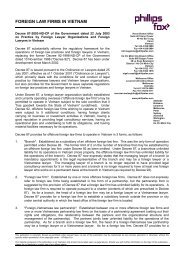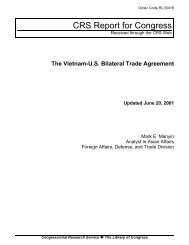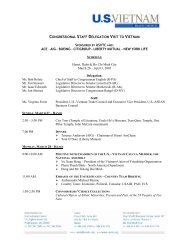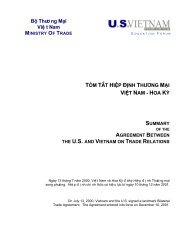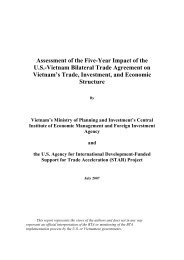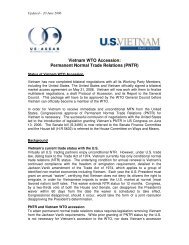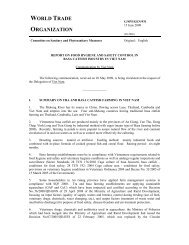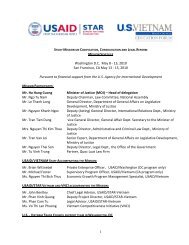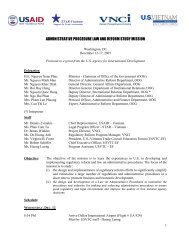Climate risks and adaptation in Asian coastal megacities: A synthesis
Climate risks and adaptation in Asian coastal megacities: A synthesis
Climate risks and adaptation in Asian coastal megacities: A synthesis
- No tags were found...
You also want an ePaper? Increase the reach of your titles
YUMPU automatically turns print PDFs into web optimized ePapers that Google loves.
dump<strong>in</strong>g of solid waste <strong>in</strong>to the city’s canals <strong>and</strong>waterways, poor dredg<strong>in</strong>g of canals, siltation ofdra<strong>in</strong>s, deforestation <strong>and</strong> soil erosion <strong>in</strong> the upperwatershed, <strong>and</strong> l<strong>and</strong> use patterns—are also critical<strong>and</strong> should be part of a broader <strong>and</strong> multisectoralapproach to address<strong>in</strong>g urban <strong>adaptation</strong>.Important to consider variation <strong>in</strong> climate<strong>risks</strong> <strong>and</strong> factors contribut<strong>in</strong>g to flood<strong>in</strong>gAn important f<strong>in</strong>d<strong>in</strong>g of this study is that whilea comb<strong>in</strong>ation of climate-related factors can contributeto urban flood<strong>in</strong>g, some factors are muchmore important than others <strong>in</strong> different cities. For<strong>in</strong>stance, <strong>in</strong> HCMC, storm surges <strong>and</strong> sea levelrise are important factors contribut<strong>in</strong>g to flood<strong>in</strong>g.However, <strong>in</strong> Bangkok these factors seem tobe relatively less important. In part this has todo with the location, elevation, <strong>and</strong> topographyof the city. The policy implication is that <strong>adaptation</strong>measures need to be designed based on thespecific hydrological <strong>and</strong> climate characteristicsof each city.Need for greater emphasis on ecosystembasedapproachesIn all of the cities considered, an important focusof flood management <strong>and</strong> control is on hard<strong>in</strong>frastructure solutions. However, the studies(Bangkok <strong>and</strong> HCMC) show that ecosystem-basedapproaches are also important <strong>and</strong> can be usefullycomb<strong>in</strong>ed with <strong>in</strong>frastructure <strong>in</strong>terventions. TheHCMC study, for <strong>in</strong>stance, argues for comb<strong>in</strong><strong>in</strong>gconstruction of dykes (as approached by theplanned flood control measure) with management<strong>and</strong> rehabilitation of the mangrove systems <strong>in</strong> CanGio, reforestation of the Dong Nai River Bas<strong>in</strong> upperwatersheds, river <strong>and</strong> canal bank protection,<strong>and</strong> implementation of bas<strong>in</strong>-wide flow managementstrategies. Urban wetl<strong>and</strong>s provide a rangeof services, <strong>in</strong>clud<strong>in</strong>g flood resilience, allow<strong>in</strong>ggroundwater recharge <strong>and</strong> <strong>in</strong>filtration, <strong>and</strong> provid<strong>in</strong>ga buffer aga<strong>in</strong>st fluctuations of sea level <strong>and</strong>storm surges. Rehabilitation of urban wetl<strong>and</strong>s istherefore critical. Upstream protection of watershedsthrough reforestation is also important <strong>in</strong>manag<strong>in</strong>g the release of runoff <strong>in</strong>to the reservoirsthat serve urban residents. These options need tobe considered <strong>in</strong> develop<strong>in</strong>g a comprehensive approachto urban <strong>adaptation</strong>. Dykes themselves aresusceptible to erosion by ra<strong>in</strong>fall <strong>and</strong> storms. Assuch, it is also important to consider protection ofdykes through plant<strong>in</strong>g.Importance of locally <strong>in</strong>duced climatechange factorsEven though this report does not take <strong>in</strong>to accountlocally <strong>in</strong>duced climate change factors, these arevery significant (Grimm et al. 2008). For example,the rate of <strong>in</strong>crease of temperature <strong>in</strong> HCMC is almostdouble that of the surround<strong>in</strong>g Mekong Deltaregion. Between 1997 to 2006, the average temperatureof HCMC <strong>in</strong>creased .34° C compared to .16° Cfor the Mekong Delta region. This <strong>in</strong>crease <strong>in</strong> temperaturefor HCMC has co<strong>in</strong>cided with <strong>in</strong>creas<strong>in</strong>gurbanization <strong>in</strong> the city. In HCMC, the heat isl<strong>and</strong>effect is chang<strong>in</strong>g the climate <strong>and</strong> urbanization ishav<strong>in</strong>g a significant effect on <strong>in</strong>creases <strong>in</strong> temperature,ra<strong>in</strong>fall, <strong>and</strong> flood<strong>in</strong>g <strong>in</strong> <strong>and</strong> around HCMC.Further analysis is needed to better underst<strong>and</strong>this issue.Lessons on Methodologyfor Follow-up StudiesEven though analysis similar to that undertaken<strong>in</strong> this report has been carried out for cities <strong>in</strong> developedcountries (Rosenzweig et al. 2007), it hasso far not been done <strong>in</strong> develop<strong>in</strong>g country cities.Moreover, preparation of this report has spurredsimilar studies <strong>in</strong> other cities <strong>in</strong> the Africa <strong>and</strong>Middle East <strong>and</strong> North Africa regions. It is importanttherefore to conclude with a few lessons forfollow-up studies.Approaches to downscal<strong>in</strong>gIn this study two different approaches to downscal<strong>in</strong>gwere used, namely statistical scal<strong>in</strong>g usedby JICA <strong>and</strong> use of a dynamic regional model asdone by the HCMC study. Each method has itsstrengths <strong>and</strong> limitations. Dynamic regional modelscan simulate daily <strong>in</strong>formation on a broad range of78 | <strong>Climate</strong> Risks <strong>and</strong> Adaptation <strong>in</strong> <strong>Asian</strong> Coastal Megacities: A Synthesis Report



